ISSN ONLINE(2278-8875) PRINT (2320-3765)
ISSN ONLINE(2278-8875) PRINT (2320-3765)
S.Swarna Latha1, P.V.Lakshman Kumar2,
|
| Related article at Pubmed, Scholar Google |
Visit for more related articles at International Journal of Advanced Research in Electrical, Electronics and Instrumentation Engineering
Now a day video processing became very popular on the contrary video content require very large storage area. To the benefit of reduce storage area we need to remove redundant data. In this practice we need to estimate the motion vectors to preserve quality. Motion vector estimation is the heart of the video processing. Conversely the mechanism of motion vector estimation normally suffers from the problems such as ambiguities of motion trajectory and illumination variances. In this paper we presents a new approach using Wavelet domain Block Matching (WBM) method and Set Partitioning In Hierarchical Trees (SPIHT) algorithm for video compression. And measured performance using parameters like mean squared error (MSE), peak signal to noise ratio (PSNR), compression ratio and structural similarity index (SSIM).
Keywords |
| WBM, SPIHT, motion estimation, SSIM. |
INTRODUCTION |
| In recent years, hardware technologies and standard activities have matured to the point that it is becoming to feasible to transmit, storage, process and view video signals that are stored in digital formats, and to share video signals between different platforms and application areas. This is a natural evolution, since temporal change, which is associated with motion of some type, is often the most important property of visual signal. |
| Video compression plays a vital role in modern multimedia applications. In video there is a considerable amount of redundancy and compression can be achieved by using such redundant data. The redundancy of video data can be reduced by removing the correlation among the elements. Still image compression based on removing the spatial or intra frame correlation. On the other hand, videos and movies are made up of a temporal sequence of frames and are projected at a proper rate (24 fps for movie and 30 fps for TV) to create the illusion of motion. This means that there exists a high correlation between adjacent temporal frames so that when projected at a proper rate, smooth motion is seen. Correlation between adjacent temporal frames is called inter frame correlation. In inter frame compression we remove the redundant data present in the adjacent frames where as in intra frame compression remove redundant data present within the frame. When we apply wavelet transform, it decomposes a video frame into a set of sub frames with different resolutions corresponding to different frequency bands. These multi resolution frames will provide a representation of the global motion structure of the video signal at different scale levels. The motion activities for a particular sub frame at different resolutions are different but have high correlation since they actually specify the same motion structure at different scale levels. |
| In this we use new method for partitioning the wavelet coefficients into spatial-temporal (s-t) blocks to get higher error flexibility and to support error suppression. Instead of grouping nearby coefficients, we group coefficients in some fixed intervals in the lowest sub band to get interleaved trees. All of the sub-blocks correspond to a group of full frames within the image sequence, because each group of interleaved trees has coefficients dispersed over the entire frame group. Then we separate the stream into fixed length packets and encode every one with a channel code. Experiments show that this proposed method brings higher error flexibility in noisy channels since the decoded coefficients associated with early decoding error would be spread out to the whole area along with the sequence, and we can recover the lost coefficients with the surrounding coefficients even if some of sub streams are totally missing. Basic video compression modal for motion vector estimation shown in figure.1 |
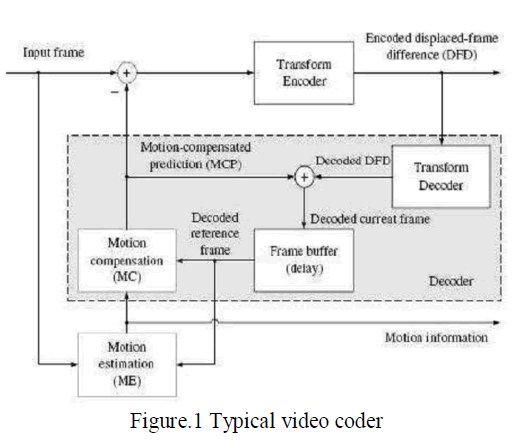 |
| In this paper we implements a new approach using wavelet based block matching method and then predicted error will be encoded using spiht algorithm. In this way we get moderate compression ratio with acceptable visual quality |
WAVELET BASED VIDEO CODER |
| Video encoder block diagram(figure.2) functions, when we give input as a video it checks for every frame whether it is key frame or delta frame. Then encoder decide to compress frame as per their type. We need to keep reference frames same both at encoder and decoder |
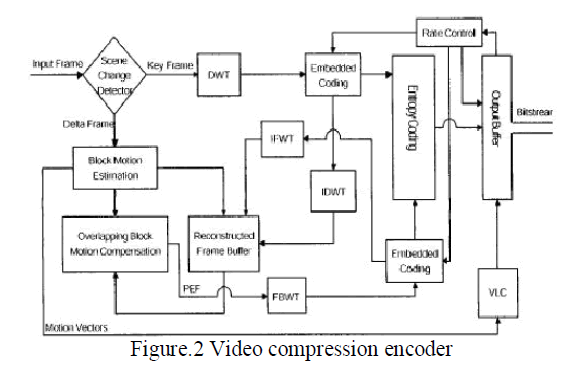 |
| At the decoder reverse process occured decoding the input stream then combine that error with reference frame then construct the original frame from that refernce frame. |
PROPOSED METHOD |
i)Wavelet domain Block Matching Method |
| Block matching is a spatial domain process. In block matching technique, a block of pixels in the current frame is matched to a same size block of pixels in the reference frame using a suitable matching criterion. Because the matching process is computationally intensive and the motion is not expected to be significant between adjacent frames, the matching process is limited to a search window of a much smaller size than the image frame. There are several matching criteria in those appropriate one will be choose. |
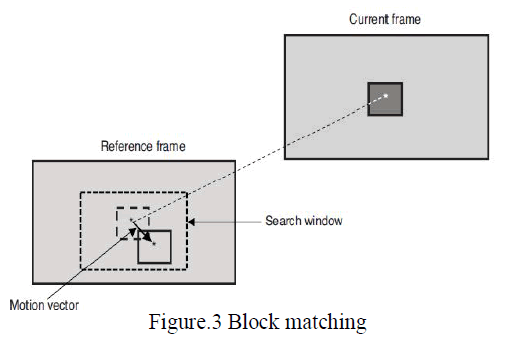 |
| In this paper we perform wavelet transform on given input frame then we perform block matching method on these wavelet coefficients |
ii)Set Partitioning In Hierarchical Trees(SPIHT) |
| This algorithm sorting the given wavelet coefficients according to their magnitudes and grouping those coefficients based on magnitudes. It divides the coefficients into three groups those are significant pixels, insignificant pixels and insignificant sets. It runs a loop until all the coefficients transmitted. It gives priority to significant pixels in every loop to transmit. It transmits group of bits into stream so rate control is also possible. Insignificant loss will occur. We can recover those coefficients which are loosed in the process by using neighbouring coefficients at the decoder simply. |
iii) Steps of algorithm |
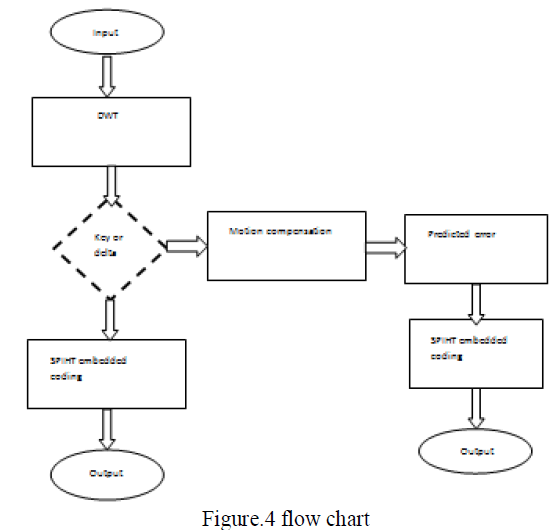 |
| First we give video as a input it divides into number of frames. Then we apply dwt transform on each frame and found wether it is key(independent) or delta(dependent) frame. If it is key frame we apply spiht directly and transmit otherwise we process motion estimation between key and delta frames and predicted error will be calculated. Then we implement spiht on this error and transimit. |
iv)Coding And Decoding |
| If the current frame is key frame then we apply the SPIHT coding algorithm to code the decomposed key frame and convert it in to the bit stream and send to the decoder. We also keep this key frame in the buffer to calculate the prediction error frame for next frame. If the current frame is the delta frame then we first calculate the motion vector using the delta frame and the key frame stored in the buffer. We transmit these motion vectors to the decoder and also explicit theses motion vectors to compensate the key frame according to the current delta frame. We then calculated the difference between the delta frame and the motion compensated key frame to generate the prediction error frame (PEF). We code this PEF in the same manner as that of key frame. It is to be noted that we assign 1/3 rd amount of bits to PEF as compared to the key frame as it contain very less information. |
| In decoding part we use inverse steps as that of a coding. At the receiver end we first receive the bit stream of the key frame. We reconstruct this key frame using the inverse SPIHT and then applying inverse DWT. Then we receive the motion vectors, we use these motion vectors to adjust the first frame. At last we receive the bit stream of PEF, we add this decoded PEF in the motion adjusted first frame to generate the second frame. We keep on doing the same procedure till next key frame comes. And till last frame of the video |
EXPERIMENTAL RESULTS |
| In simulation we have consider standard video. The videos we consider has few scene change, so we consider every fifth frame as a key frame for the coding. To check the compression performance we use the compression ratio and structural similarity index |
 |
| Here cr-compression ratio |
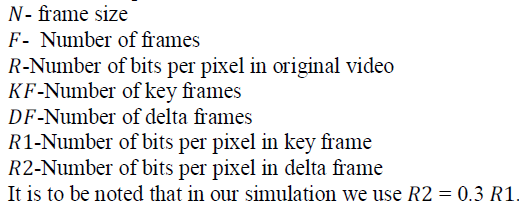 |
| The Structural Similarity (SSIM) index is a method of measuring the similarity between two images. The SSIM index can be viewed as a quality measure of one of the images being compared provided the other image is regarded as of perfect quality |
 |
| From the Table.1 old means existing method and new means our proposed method. In table we take parameters like Avg.MSE, Avg.PSNR, Avg.ssim because we measured these parameters for every frame of the video and then measured their average |
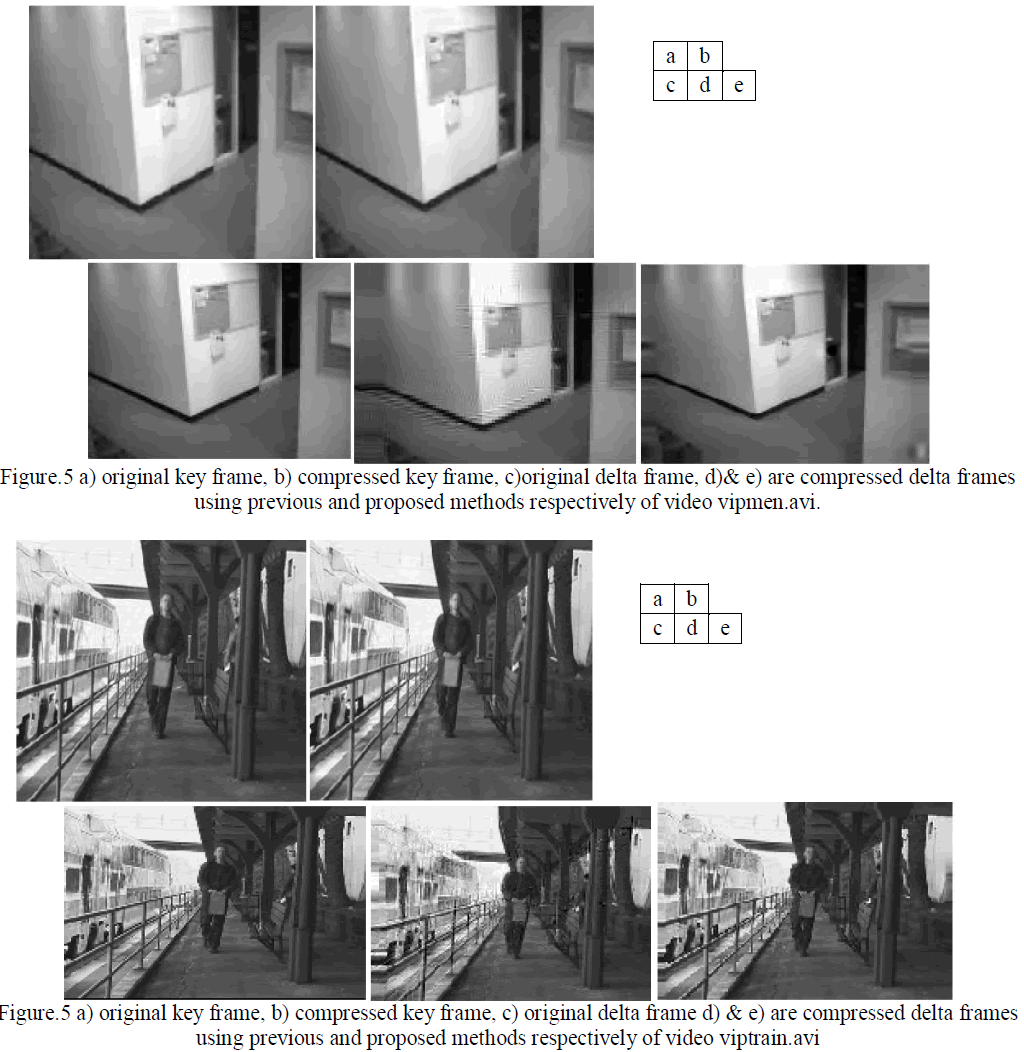 |
CONCLUSIONS |
| From the table it is clearly understood our proposed method shows good results mean in the values of compression ratio and peak signal to noise ratio. In this paper we calculate values maintaining key frame rate and delta frame rate in the ratio 3:1. When compression ratio increases visual quality will be decreased. So we will choose between visual quality and compression ratio. After reaching certain limit of compression ratio it will degrade the video. The reconstructed video is similar to the original video but slightly blurred |
FUTURE SCOPE |
| We can improve results using different searching methods in the motion estimation and different combinations of bitrates of key frame and delta frame. |
References |
|